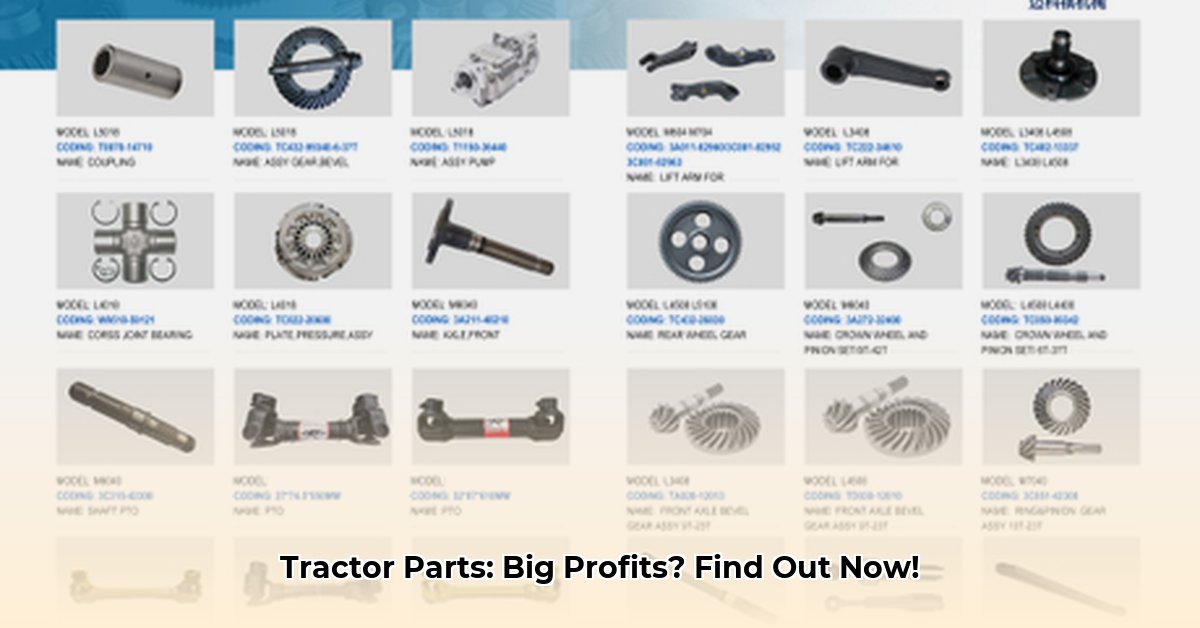
Tractor Parts Manufacturing: A Comprehensive Overview
The global tractor parts market represents a complex interplay of Original Equipment Manufacturers (OEMs) – those who produce the tractors themselves – and a diverse network of aftermarket suppliers offering compatible components. This dynamic landscape presents both significant opportunities and considerable challenges. Understanding the market's key trends and dominant players is crucial for success within this sector. Do you know what factors separate the thriving manufacturers from those struggling to keep pace? For more on tractor manufacturers, see this list.
One key factor driving market success is the increasing demand for high-quality, durable parts. Farmers rely on their equipment for their livelihood, and downtime due to part failure translates directly to lost revenue. This heightened demand fuels opportunities for manufacturers focused on robust, reliable designs and superior materials. Furthermore, the integration of smart technologies into modern farming practices is impacting the sector. Precision agriculture and automation initiatives necessitate the development of advanced parts incorporating sensors, data analytics, and sophisticated control systems. This places a premium on manufacturers capable of adapting to rapid technological advancements.
Major Players and Market Segmentation
The global tractor parts market is characterized by a blend of large multinational corporations and specialized niche players. Some manufacturers concentrate on providing a wide array of parts suitable for various tractor brands and models, while others specialize in specific components, such as engines, transmissions, or hydraulic systems. This segmentation strategy allows for focused expertise and efficient resource allocation. However, maintaining a competitive edge demands constant innovation and a deep understanding of emerging market trends. What are other strategies employed by leading manufacturers?
OEM vs. Aftermarket: A Key Distinction
OEM (Original Equipment Manufacturer) parts are produced by the same companies that manufacture the tractors themselves. These parts are typically more expensive but offer guaranteed fit, performance, and warranty coverage. Aftermarket suppliers, on the other hand, offer alternatives that are often more budget-friendly, but quality and compatibility can vary significantly. The choice between OEM and aftermarket parts frequently depends on a careful cost-benefit analysis, balancing upfront expenditure with long-term reliability and potential warranty considerations. What are the specific financial considerations for small-scale farmers?
Technological Advancements Reshaping the Industry
The tractor parts manufacturing industry isn't static; it's a dynamic field continuously evolving in response to technological advancements. 3D printing, for example, is gaining traction, enabling customized part production and faster prototyping. The use of advanced materials, such as high-strength, lightweight alloys, improves the durability and efficiency of tractor components, directly impacting fuel economy and operational efficiency. These innovations not only enhance product performance but also contribute to a more sustainable approach to tractor part manufacturing. What emerging technologies promise to further disrupt this industry?
Supply Chain Management and Global Distribution
The global nature of the tractor parts manufacturing industry necessitates robust and resilient supply chains. Sourcing raw materials, manufacturing components, assembling final products, and distributing to dealers and end-users worldwide requires meticulous planning and execution. Geopolitical instability, natural disasters, and unexpected disruptions can significantly impact supply chain efficiency and, in turn, part availability and pricing. As a result, manufacturers are embracing strategies to mitigate risk, such as diversifying sourcing, investing in resilient logistics networks, and adopting just-in-time inventory management techniques. How are companies adapting to the complex challenges of global supply chain management?
Quality Control and Industry Certifications
Ensuring consistently high quality is paramount within the tractor parts industry. Reputable manufacturers invest heavily in quality control measures, implementing stringent standards and testing protocols throughout their production processes. Many parts comply with and meet specific industry standards, often obtaining certifications guaranteeing quality and safety. These certifications help build customer trust, offering farmers assurance that purchased components will meet performance expectations. This commitment to quality helps build lasting customer relationships and reinforces a manufacturer's reputation for reliability. What are the major international certifications relevant to this industry?
Choosing the Right Parts Supplier: A Buyer's Guide
Selecting a reliable parts supplier is a critical decision for farmers. Consider several key factors:
- Reputation and Reviews: Research the supplier's reputation through online reviews and industry testimonials.
- Part Availability: Verify the supplier's ability to provide needed parts promptly.
- Pricing and Warranty: Compare prices and carefully consider warranty terms.
- Customer Service: Assess the supplier's responsiveness and willingness to assist.
- Certifications: Look for certifications confirming quality and safety compliance.
The Future of Tractor Parts Manufacturing: Trends and Predictions
The tractor parts industry's future is poised for growth, driven by increasing demand for high-efficiency tractors and advancements in precision agriculture. However, manufacturers must navigate emerging challenges, including stricter environmental regulations and a growing emphasis on sustainable manufacturing practices. The trend toward increased automation in agriculture will further influence the types of parts required and the manufacturing processes employed. What are the key challenges and opportunities facing this industry in the next decade?
Top 5 Tractor Parts Manufacturers (Illustrative Example - Replace with Actual Data):
- [Manufacturer Name]
- [Manufacturer Name]
- [Manufacturer Name]
- [Manufacturer Name]
- [Manufacturer Name]
(Note: This list requires replacement with actual market data.) This information provides a foundation for a deeper dive into the specifics of each manufacturer’s operations, market share, and strategic initiatives.
This detailed examination of the tractor parts manufacturing industry reveals a dynamic and complex sector. Understanding the market trends, major players, and technological advancements enables informed decision-making for both manufacturers and consumers. The focus on quality, reliability, and efficient supply chains remains crucial for long-term success and profitability within this vital agricultural support sector.